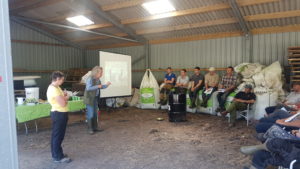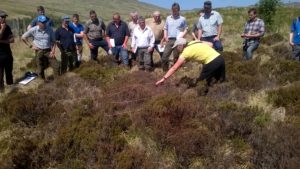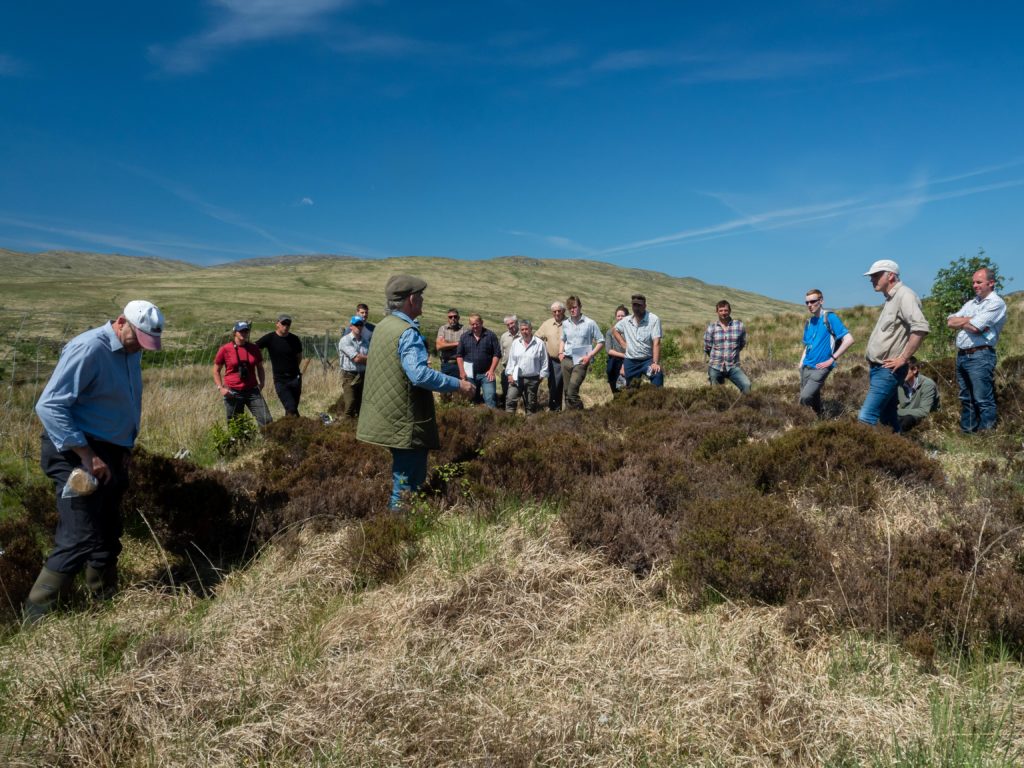Upland Habitats and Impacts of Herbivores, Isle of Jura – Event summary
29 May 2018The impacts of grazing of both domestic and wild herbivores affects the long term sustainability of upland habitats. For upland managers it is important to recognise these different upland habitats and be able to identify their condition in relation to management. Habitat condition, as indicated by the vegetation type, cover and height is determined by the level of grazing and trampling. Good habitat condition is important for supporting wildlife and for optimum carbon storage capacity both important factors in sustainable land management.
as indicated by the vegetation type, cover and height is determined by the level of grazing and trampling. Good habitat condition is important for supporting wildlife and for optimum carbon storage capacity both important factors in sustainable land management.
A simple habitat assessment can be carried out at plots across each habitat type to give a base-line of habitat condition. Regular assessments can be used to show local grazing or trampling pressures and trends over a period of time on an upland estate or at a wider deer management group level. The information can be used to help set targets for stock or deer management and enable managers to understand how their management of herbivores is affecting the moorland habitats and wherechanges could be made.
This meeting started in a shed on Ardlussa estate on the remote north end of Jura. The first part included an introduction and presentation by Helen Bibby a Conservation consultant from SAC, on upland habitat types and their main characteristics including peat depth and vegetation and the impact of different types of herbivore. The second presentation also by Helen focussed on how to examine these impacts using standard and recognised means using SNH best practice guides. There was an explanation of the value of the peatland habitats for wildlife, carbon and water followed by discussion. Professor Rory Putman gave an introduction to the practicalities of using this technique and provided more information to enable surveyors to use additional techniques in the field.
Following the presentations the attendees were taken to hill ground where the different upland habitats could be identified and grazing, trampling and tracking impacts could be examined closely. Refreshments in the field allowed attendees to discuss techniques. There was a lot of opportunity for discussion and lots of questions asked regarding the practicality of assessment in the field.
Please use the links below to access the presentations given on during the event and to download the information available to take home.
- Impacts of deer on upland habitats – presentation slides by Helen Bibby
- These are the 'Impacts of deer on upland habitats' presentation slides used by Conservation consultant Helen Bibby during the Upland habitats and Impact of herbivores event on Jura during May 2018
- Topics: Climate Change and Rural Business
- Habitat monitoring presentation slides by Helen Bibby
- These are the 'Habitat monitoring' presentation slides used by Conservation consultant Helen Bibby during the Upland habitats and Impact of herbivores event on Jura during May 2018
- Topics: Climate Change and Rural Business
- Habitat impact assessments checksheet
- This 'Habitat impact assessment checksheet' was provided as part of the delegate pack to support the 'Upland Habitats and Impacts of Herbivores' event held on the Isle of Jura during May 2018
- Topics: Climate Change and Rural Business
- FAS: Guidance for Habitat Impact Assessment Surveys
- This guidance document explores Habitat Impact Assessment Surveys. Assessing the habitat impacts of grazing on habitats requires looking at the various effects of herbivores, notably red deer, on the main habitats that occur in the uplands. These habitat types are dwarf shrub heath (wet & dry) and blanket bog, which are the most extensive habitats in the uplands.
- Blanket Bog Data Sheet – Habitat Impact Assessment
- A copy of a data sheet that can be used in an Upland habitat impact assessment.
- Topics: Climate Change
- Dwarf shrub heath data sheet – Habitat Impact Assessment
- A copy of a data sheet that can be used to monitor dwarf shrub in an upland habitat impact assessment
- Topics: Climate Change
- Technical Note (TN686): Conservation Grazing for Semi-Natural Habitats
- Grazing is an important process in maintaining semi-natural grasslands, wetlands and heathlands of conservation interest. This technical note provides guidance on developing grazing plans for a range of habitats in Scotland.
- Impact indicators in upland habitats – information sheet
- This is a copy of an information sheet available at the Upland Habitat and Impact of Herbivores event.
- Topics: Climate Change
- Impact indicators for upland habitat assessment
- This 'Impact indicators for upland habitat assessment' information leaflet was part of the delegate pack supplied to support the 'Upland Habitat and Impact of Herbivores' event held on the Isle of Jura during May 2018
- Topics: Climate Change and Rural Business
Sign up to the FAS newsletter
Receive updates on news, events and publications from Scotland’s Farm Advisory Service

